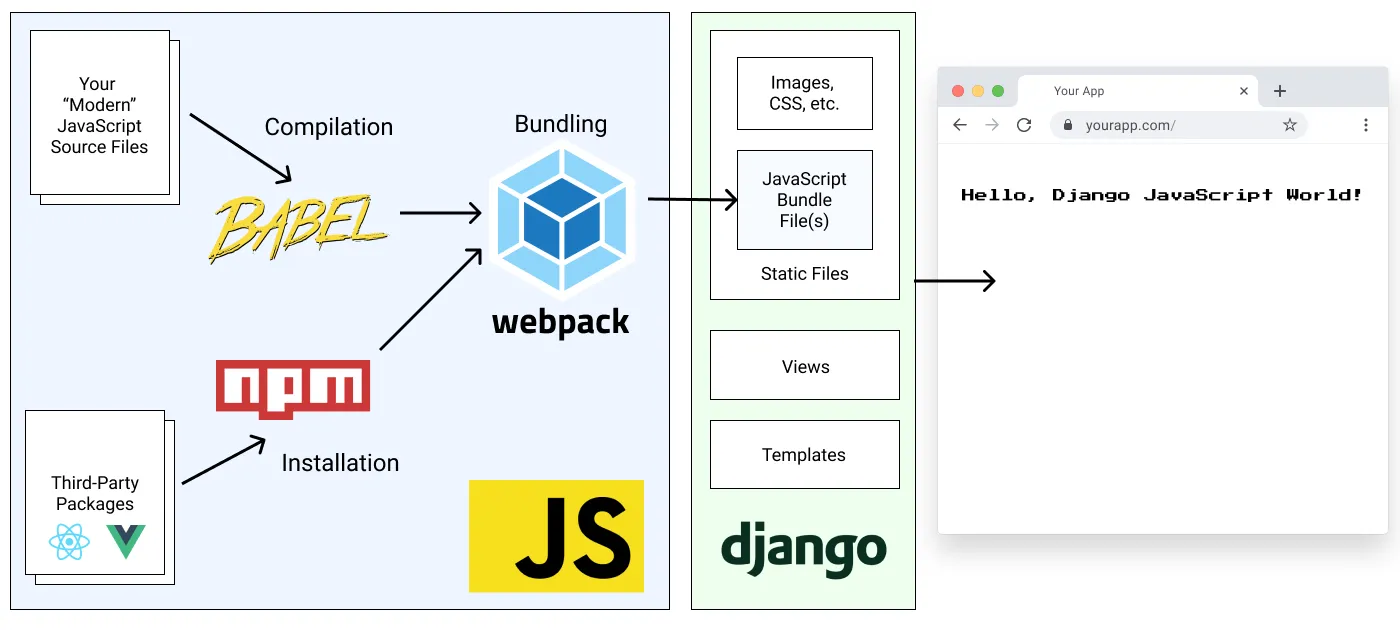Front End Overview
This page documents the front end files that are integrated into Django. See the standalone front end docs for the separate React front end.
Architecture
Section titled “Architecture”Pegasus’s front-end architecture is a hybrid model, with a front-end codebase that is compiled and used directly in Django templates via Django’s static files infrastructure.
There are two setups, one built on top of Webpack, and a more modern one built on top of Vite. The architecture of these is very similar, just built on different tools.
Big picture, the front end consists of a build tool (Vite or Webpack) and a compiler (esbuild or Babel) which compiles the front-end code into bundle files that can be referenced using Django’s static file system, as represented in the diagram below.
Vite

Webpack

Pegasus’s styles use either the Tailwind, Bootstrap or Bulma CSS frameworks, and building the CSS files is included as part of the front-end build pipeline. For more details on CSS in Pegasus, see the CSS documentation.
For a much more detailed overview of the rationale behind this architecture, and the details of the set up see the Modern JavaScript for Django Developers series.
Choosing a front end build tool
Section titled “Choosing a front end build tool”Pegasus currently lets you choose between Vite and Webpack as the primary build tool for your front end. Choosing is relatively simple: if you don’t know what you want, use Vite.
Vite is faster, more modern, and includes a number of features not supported by webpack, including:
- Hot Module Replacement (HMR)---a development feature that lets code changes in your front end files automatically update without a full-page reload.
- Code splitting---a production feature that breaks your front end files into individual bundles that encapsulate code dependencies. This leads to less redundant JavaScript and faster page loads.
The main reason to choose Webpack is if you are already using it and don’t want to switch tools. See this video for more on the benefits of Vite over Webpack.
Front-end files
Section titled “Front-end files”The source front-end files live in the assets directory, while the compiled files
get created in the static directory.
Generally you should only ever edit the front-end files in assets directly,
and compile them using the instructions below.
Prerequisites to building the front end
Section titled “Prerequisites to building the front end”To compile the front-end JavaScript and CSS files it’s expected that you have installed:
Pegasus is developed and tested on the latest LTS releases, which (at the time of this writing) are Node version 22 and npm 11. Later versions will likely work, but aren’t regularly-tested.
It’s recommended to use nvm to manage different node/npm environments more easily.
nvm is essentially virtualenv for Node.js/npm.
Alternatively, you can build and run your front end with Docker. However, this has been known to cause performance problems in some environments.
Initial setup
Section titled “Initial setup”Once you’ve installed Node and NPM, you can install your front end dependencies by running:
npm installor in Docker:
make npm-installIn your project’s root directory. This will install all the dependencies necessary to build the front end.
It will also generate a package-lock.json file.
It is recommended that you add the package-lock.json to source control for consistency across installations.
Building in Development
Section titled “Building in Development”The development set up is slightly different between Vite and Webpack. For details see these links:
Building for production
Section titled “Building for production”To build for production, run:
npm run buildor in Docker:
make npm-buildThis will compress your files, remove logging statements, etc. In most supported deployment set ups, this will be run automatically for you as part of your deployment.
TypeScript and type checking
Section titled “TypeScript and type checking”Since the 2022.6 release, Pegasus includes TypeScript as part of the front end code. You can write TypeScript or JavaScript code and it will be transpiled to work in a browser as part of the build pipeline.
The build pipeline does not explicitly do type checking. To do type checking you can run:
npm run type-checkOr in Docker:
make npm-type-checkType checks will also automatically run on new pull requests if you have enabled Github Actions on your project.
